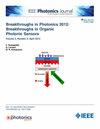Polarization-Insensitive Nano-Metamaterial Sensor With Near-Infrared μ and ϵ Negative Properties for Early Cancer Detection via Exosome Analysis (70 THz to 3 PHz)
IF 2.1
4区 工程技术
Q3 ENGINEERING, ELECTRICAL & ELECTRONIC
引用次数: 0
Abstract
Metamaterials (MTMs) have emerged as essential components in high-performance electromagnetic devices, including sensors and absorbers. This study presents a polarization-insensitive nano-metamaterial sensor with exceptional angular stability and a wide operating range of 70 THz to 3 PHz. The sensor achieves an average absorption rate of 97% across this range, making it highly suitable for applications in biomedical engineering. By integrating microwave imaging (MWI) techniques, the sensor can detect circulating cancer exosomes (CCEs) with high sensitivity, effectively distinguishing them from normal exosomes. Exhibiting double-negative MTM properties (negative permittivity and permeability) in the near-infrared (NIR) range (70 THz to 400 THz), the sensor enhances sensitivity for early cancer detection. A detailed analysis of its properties, including impedance (Z), phase, and S11 parameters (real and imaginary components), demonstrates its superior performance. This non-invasive, label-free approach to detecting cancer biomarkers represents a significant step forward in advancing personalized healthcare.具有近红外μ和ε负特性的偏振不敏感纳米超材料传感器用于外显体分析早期癌症检测(70 THz至3 PHz)
超材料(mtm)已成为高性能电磁器件的重要组成部分,包括传感器和吸收器。本研究提出了一种偏振不敏感的纳米超材料传感器,具有出色的角稳定性和70太赫兹到3 PHz的宽工作范围。该传感器在此范围内的平均吸收率为97%,非常适合生物医学工程的应用。通过集成微波成像(MWI)技术,该传感器可以高灵敏度地检测循环癌外泌体(CCEs),有效地将其与正常外泌体区分开来。该传感器在近红外(NIR)范围内(70太赫兹至400太赫兹)表现出双负MTM特性(负介电常数和负磁导率),提高了早期癌症检测的灵敏度。详细分析了其性能,包括阻抗(Z),相位和S11参数(实虚分量),证明了其优越的性能。这种无创、无标签的检测癌症生物标志物的方法是推进个性化医疗保健的重要一步。
本文章由计算机程序翻译,如有差异,请以英文原文为准。
求助全文
约1分钟内获得全文
求助全文
来源期刊

IEEE Photonics Journal
ENGINEERING, ELECTRICAL & ELECTRONIC-OPTICS
CiteScore
4.50
自引率
8.30%
发文量
489
审稿时长
1.4 months
期刊介绍:
Breakthroughs in the generation of light and in its control and utilization have given rise to the field of Photonics, a rapidly expanding area of science and technology with major technological and economic impact. Photonics integrates quantum electronics and optics to accelerate progress in the generation of novel photon sources and in their utilization in emerging applications at the micro and nano scales spanning from the far-infrared/THz to the x-ray region of the electromagnetic spectrum. IEEE Photonics Journal is an online-only journal dedicated to the rapid disclosure of top-quality peer-reviewed research at the forefront of all areas of photonics. Contributions addressing issues ranging from fundamental understanding to emerging technologies and applications are within the scope of the Journal. The Journal includes topics in: Photon sources from far infrared to X-rays, Photonics materials and engineered photonic structures, Integrated optics and optoelectronic, Ultrafast, attosecond, high field and short wavelength photonics, Biophotonics, including DNA photonics, Nanophotonics, Magnetophotonics, Fundamentals of light propagation and interaction; nonlinear effects, Optical data storage, Fiber optics and optical communications devices, systems, and technologies, Micro Opto Electro Mechanical Systems (MOEMS), Microwave photonics, Optical Sensors.
 求助内容:
求助内容: 应助结果提醒方式:
应助结果提醒方式:


